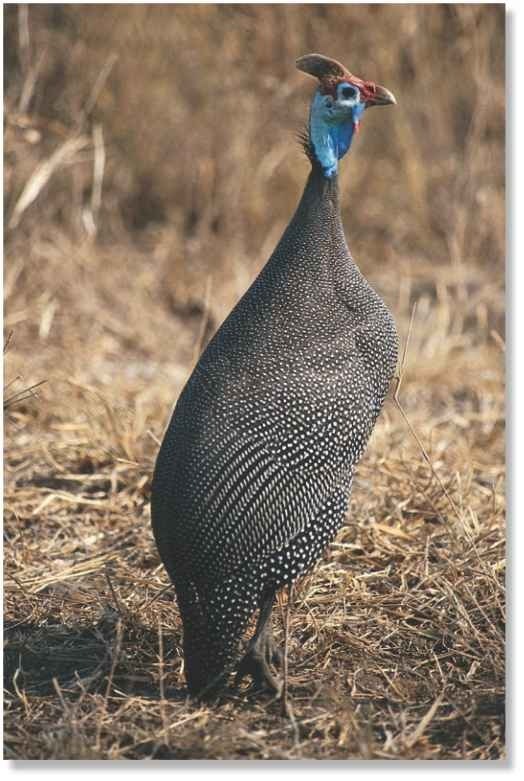ORDER
Galliform.es
FAMILY
Numididae
GENUS & SPECIES
KEY FEATURES
• Most gregarious pecies in the Galliformes order; up to 2,000 helmeted guineafowl congregate at watering holes
• Male guineafowl chase each other in wild dashes for up to 10 minutes as part of dominance rituals
• Flocks of helmeted guineafowl march in single-file lines to both foraging and drinking areas
WHERE IN THE WORLD?
Found in Africa south of the Sahara; from Senegal, east to Somalia, south to South Africa, as well as Morocco in the northwest, Comoros Islands and Madagascar in the southeast
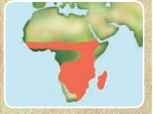
Lifecycle
Flocks of helmeted guineafowl resemble soldiers as their troops advance single file toward a watering hole or form a close-knit cluster to protect their young.
HABITAT
The helmeted guineafowl inhabits Africa’s open country, from the gulf of Guinea (hence the name) to South Africa. The flock usually chooses a roosting tree as the central point of its home range. The guinea-fowl travels 0.5-15 miles from its roost each day, but always returns at night. It searches for new water sources and large patches of vegetation. The helmeted guineafowl is most common in moist, grassy savannahs with scattered acacia and baobob trees, but it roams from forest edge to arid plains to thorny scrubland. The 20-50″ of rain each year in these areas supports vegetation for foraging, and the guineafowl can usually be found in the areas where the scattered rains are heaviest.
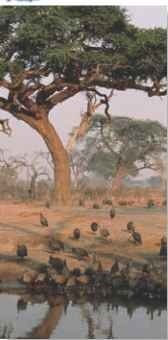
Beautiful Botswana A roost, foraging patch and drinking hole are a home’s essential features.
The helmeted guineafowl’s eggs are only 2″ long, but have a shell thick enough to withstand grass fires.
The only time the helmeted guineafowl leaves the flock is during the breeding season. It returns with its keets after 3 months.
FOOD & FEEDING
The guineafowl forages twice each day, once at dawn and once in the afternoon. Departing from home base, the flock proceeds single file toward a watering hole for a communal drink. Dominant males act as the leaders of the line and lookouts. After a drink, the guineafowl sweep the savannah. Walking shoulder to shoulder;
they patrol the tall grasses and peck at the ground, randomly picking up food. Seeds form the bulk of the guineafowl’s diet, along with wheat and other grains that are available. In the dry season, the birds scratch the ground to expose ghly nutritious tubers, bulbs and roots. Corn ernels are also a staple, but the birds are not considered pests because they feed only on fallen or discarded cobs. Spiders and insects, especially grasshoppers, are targets, too.
Last but not least All guineafowl benefit equally from the flock’s single-file march to find food.

BREEDING
At the start of the breeding season, guineafowl males confront each other and then race to gain the right to mate. Up to eight males may join the competition, which can last up to 10 minutes. The females observe the race carefully and pair up with the winners. The female selects the nest site and forms a scrape in the earth about 3″ deep, lined with grass and feathers. She incubates the 8-15 eggs alone, but is later rejoined by the male; he then helps feed the chicks. The downy chicks (keets) all hatch simultaneously and mature quickly; they can fly short distances in two weeks and reach adult size in a month, but usually stay with the flock for about three months.
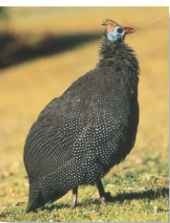
Waiting for the call Distinct mating calls distinguish the two sexes.
CONSERVATION
The helmeted guineafowl is the most common species of guineafowl. Since 400 BC, it has been raised for meat and kept as a pet. The subspecies N. m. galeata is found on farms worldwide. N. m. sabyi, of Morocco, is endangered due to habitat destruction and hunting.
BEHAVIOR
Standing at attention under a tree, the helmeted guineafowl blends into the shadows with near-perfect camouflage. The pale-white dots on the guineafowl’s dark feathers create countershading that helps hide the bird while it is in the shade.
Out in the open, however; the camouflage is much less effective. If a fellow guineafowl sounds the alarm call, the guineafowl crouches for cover: It sinks low amid the grasses and puts its bright-blue head flush against the ground. When a jackal or snake approaches the flock, the adults often remain standing and assemble into tight formation around the young. Though its short, rounded wings make the bird poorly equipped for long flights, the guineafowl occasionally flies up into trees if chased by a predator. If confronted by a predator, the male also uses its wings in an aggressive stance; it arches its wings above its back in order to appear larger.
THE DAILY GRIND
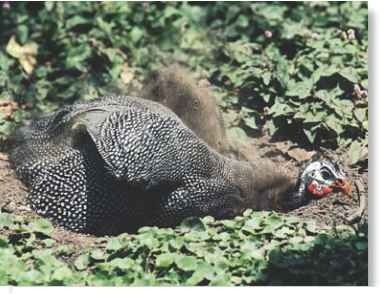

Descending…
Helmeted guineafowl descend from their tree roost each day at dawn.
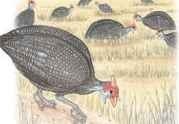
Digging…
The flock sticks together while scratching for underground tubers, bulbs and roots.
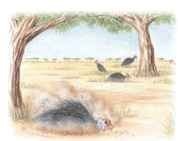
Dust bathing…
At midday, the birds cool off in the shade; one bird takes a dust bath to rid itself of parasites.

Drinking
In the late afternoon, before returning to the roost, the helmeted guineafowl grab a drink.
PROFILE
Helmeted Guineafowl
The helmeted guineafowl, with its distinct “military headgear,” marches daily to forage for everything from seeds and insects to tender grasses.
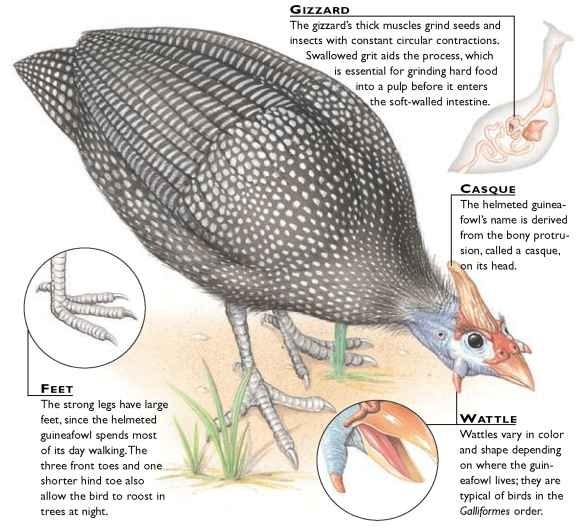
CREATURE COMPARISONS
Measuring up to 20″, the crested guineafowl (Guttera pucherani) is slightly smaller than the helmeted guineafowl. Both birds have black plumage with small spots; the crested has blue spots, the helmeted, white. While both are found in similar regions of Africa, the crested guineafowl is easily distinguished by the curly feathers that cover the top of its head. The crested guineafowl is more elusive than its relative and seeks shelter at the edge of forests.
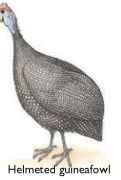

Crested guineafowl
| VITAL | |
| STATISTICS | |
| Weight | 2.5-3.5 lbs. |
| Height | 21-25″ |
| Sexual Maturity | About 7 months |
| Breeding Season | Start of the rainy season |
| Number of Eggs | 6-12 |
| Incubation Period | 24-28 days |
| Fledging Period | 14 days |
| Breeding Interval | Up to 1 year |
| Typical Diet | Omnivorous; mainly plant parts, including seeds and tubers, but also insects and spiders |
| Lifespan | 20 years |
RELATED SPECIES
• The six species of guineafowl in seven genera all inhabit Africa, though domesticated species have been introduced worldwide. Guineafowl are large birds with a proportionately small head covered by either a bony casque or feathered crest. Almost the size of chickens, guineafowl join turkeys, curassows, grouse and megapodes in the order Galliformes.
